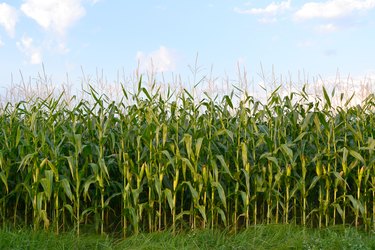
Knowing the ideal number of seeds to plant in a field can make the difference between a great yield and a disappointing one. For corn, this depends on a handful of variables, including moisture level, temperature and seed spacing. Determining the right amount of corn seeds per acre requires striking a balance between volume and economy; the best way to optimize returns on your investment isn't simply to pack your fields with as many seeds as they can carry.
Soil Condition Effects on Corn
Video of the Day
Because corn is a warm season crop, it grows best in soil that ranges between 60 to 65 degrees Fahrenheit. Once it has sprouted, it can handle much hotter air temperatures, although, like any plant, it can struggle with heat stress if it is exposed to too much atmospheric heat. Corn does not perform as well in colder temperatures that fall below the 60 degrees Fahrenheit threshold. In fact, cold and wet soil can be so inhospitable to the crop that it may prevent the corn seeds from sprouting to begin with.
Video of the Day
The best time of year to plant corn is shortly after the last frost of the winter when the soil and air temperatures have both risen above 60 degrees Fahrenheit and are unlikely to drop below that figure again. While measurement methods for the moisture content in soil differ across many studies, the ideal soil moisture for planting corn typically hovers around the 75 to 50 percent range for coarse soil and 50 to 25 percent for medium soil. After the seeds have germinated, increase irrigation.
How Should I Plant My Corn?
Knowing how and where to plant corn is just as important as selecting the right timing and conditions for planting your corn. Loosen your soil in advance to a depth of about half a foot, then plant your corn seeds at a depth of 1/2 inch to about 1 1/2 inches, depending on the temperature of the soil. The warmer the soil, the deeper the seeds should be planted.
Unlike flowering plants, which are often pollinated by animals such as bees or hummingbirds, corn is pollinated by the wind. Take advantage of this by seeding the corn in open and sunny spaces that will allow you to plant your corn in blocks rather than in long, single-file rows to increase its yield. The exact spacing of the seeds will depend on the species of corn and existing soil conditions, but 2 to 4 inches is typical.
Rules of Thumb for Planting Corn
Taking all of this into account allows farmers to reach a general conclusion about the ideal number of seeds per acre to plant: 30,000. However, this figure may vary depending on the type of irrigation your field uses and spacing between rows. Rainfed fields without controlled irrigation are usually unable to support as many seeds as irrigated fields are.
Furthermore, while it's possible to net higher yields with more seeds per acre, doing so is not always the smartest move for your wallet. Maximizing the monetary return on your crops is a balancing act that is dependent on seed prices and expected turnarounds. More corn plants will require additional fertilizer, as well. Finally, it's important to plant more than you need; anticipate crop loss so that you don't yield less than you planned.